By Louise Vas, with the guidance of Yogananth Andiappan
Poses demonstrated by Joan Wong Jolliffe
This month’s featured pose explores the inverted version of Koormasana / Tortoise pose.

Warm-up
The below focuses on shoulder rotation and movement:
Internal Shoulder Rotation
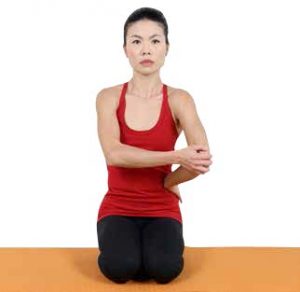
1. Sit on the heels in Vajrasana/Diamond pose and sit with the spine neutral.
2. Bring the back of the left wrist on the waist with the fingers relaxed. Hold the left elbow with the right hand and keep the shoulders down (not raised and squeezing the neck).
3. Inhale and on the exhale, pull the elbow towards the middle of the body. Hold this for two breaths and release, while repeating the practice for 3 more times.
4. Release the left hand from the waist and practice on the right side.
The below poses focus on hip flexion and hamstring extension, in preparation for the final pose.
Uttanasana / Standing Forward Bend – block use
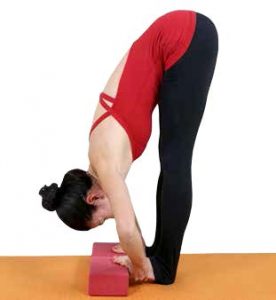
1. From a standing position, place two blocks in front of the feet and step on the blocks, pressing the balls of the feet on the blocks and the heels on the floor. Keep the legs straight and actively roll the legs inwards.
2. Hold the waist, lengthen the torso by lifting the chest and roll the shoulders back.
3. Inhale and on the exhale, bend forward from the hips, keeping the chin lifted.
4. Reach down to the blocks or the floor with the fingertips. If possible, hold the bottom of the feet. Whist holding the feet, inhale and on the exhale, bend the elbows sideways to widen the shoulders and bring the abdomen closer to the thighs.
5. Stay in the pose for a few deep breaths. To come out of the pose, hold the waist and slightly bend the knees to come up, stepping off the blocks.
Prasarita Padottanasana / Wide-legged Forward Bend
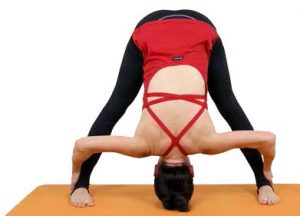
1. Start in a wide-legged standing position, legs wider than the shoulders.
2. Bring the hands to the waist. Inhale and on the exhale, lean forward and slowly slide the hands down to the thighs, then to the shins and ankles. Keep the legs straight and keep a good grip on the ankles.
3. With arms straight, inhale to look forward or look to the floor and on the exhale, broaden the shoulders, bend the elbows sideways and bring the torso closer to the thighs.
4. Keep the eyes open while in the pose. Hold for a few breaths then release.
Parivrtta Baddha Uttanasana/Revolved Bound Forward Bend
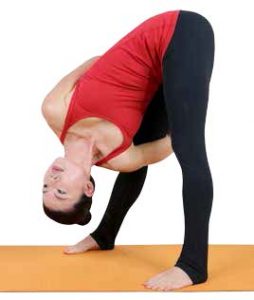
1. From Prasarita Padottanasana, move the legs slightly closer.
2. Bend the right knee and bring the right shoulder under the right thigh.
3. The left arm reaches back to hold the right hand, wrapping the arms around the thigh.
4. Inhale and on the exhale, slowly straighten the right leg. Pull the left shoulder back to keep the chest open.
5. Look straight ahead or towards the left shoulder.
6. Hold the pose for a few breaths and come out of the pose. Repeat with the left side.
Eligibility Pose
Practice the below to have a better understanding of the muscles involved in the final pose.
Baddha Trikonasana / Bound Triangle Pose
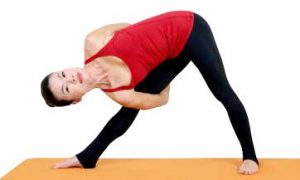
From standing with the legs together, step the right foot forward. The right foot points forward while the left foot is turned outwards, about 45 degrees to the left. Bend the front knee and slide the right forearm under the right thigh; the left hand reaches back to hold the right hand or forearm. Once the grip is secured, straighten the right knee, keep the chest open and gaze straight ahead.
Steps

1. Start in a standing position with the legs wider than the shoulders.
2. Lean forward and come into a forward bend, holding the ankles while keeping the arms and legs straight.
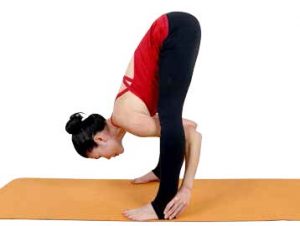
3. Bend the elbows and reach for the back of the ankles. Move the torso closer to the thighs.
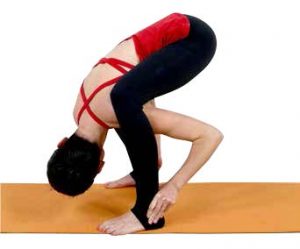
4. Bend the left knee. Turn the body to the right and slide the left shoulder under the left leg, keeping the grip on the ankle.
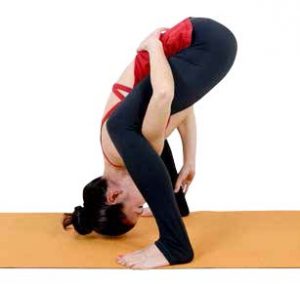
5. The left hand reaches for the lower back, while the right shoulder goes under the right thigh same as in Step 4.
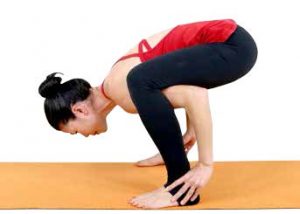
6. Lower the hips slightly higher than the knees, as if sitting on the shoulders. Hold the ankles and keep the gaze to the floor for balance.
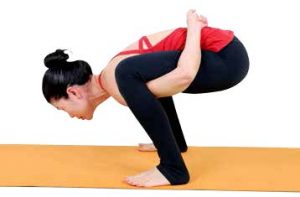
7. Interlock the fingers and look forward, extending the front of the neck.
Final Pose

Inhale and on the exhale, round the back and slowly straighten the legs.
Bring the chin closer to the chest and look upwards.
Variation
There are many ways an asana can be performed or interpreted depending on each practitioner, and classic Hatha Yoga text suggests that there are over 8 Million poses.
Below are variations of Viparita Koormasana.

Hands in Anjali Mudra/Prayer position
Instead of having the fingers interlocked, the hands can be placed together in
Anjali Mudra. The upper part of the arms is actively pressing against the thighs.

Arms extended sideways
The arms are extended sideways and the index finger and thumb are touching in cin mudra. There is less support from the arms and balance is challenged slightly.
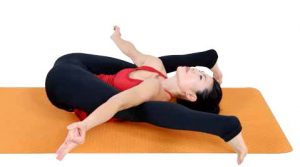
Supta Koormasana / Reclined Tortoise Pose
To practice this variation, start in a supine position and bring the legs towards the torso. Follow the steps as described and extend the arms sideways rather than reaching to hold the back.
Modifications
The below modification is available to practitioners with limited internal shoulder rotation.

Using a yoga strap is helpful in ensuring that the body is not overstretched – in this practice, using the strap extends the distance between both hands and requires less internal shoulder rotation. Hold a strap with one hand when trying to come into the pose. In this practice, focus on the forward bend more than the movement of the shoulders.
Neutralizing MOVEMENTS
Neutralizing movements are important for long-term injury prevention; it allows the body to return to its neutral position. Be aware of pressure alert points and listen to your body – do neutralizing movements after slowly coming out of the pose.

Seated Twist
Sit on the floor with the legs extended and apart, keeping the back lifted. Inhale and on exhale, turn the body to the right. Place the left hand on right knee and the right hand behind the hips and twist the body more to the right. Hold the pose for a few seconds. Inhale and return to the centre, and exhale to the left.

Parivritta Prasarita Padottanasana/ Revolved Wide-legged Forward Bend
From Prasarita Padottanasa, place both hands together in the centre, on the floor. With the right hand on the floor, inhale and on the exhale, raise the left arm in line with the shoulders and turn the body to the left. Look up and pull the left shoulder back to open the chest more. Bring the left hand to the floor and repeat the pose, twisting to the right.
Counter poses
The below counter poses will relieve any tension created in the shoulders and torso.
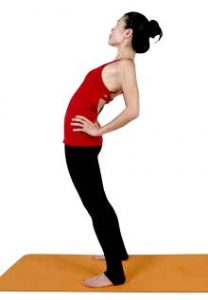
Peraiasana/Crescent Moon Pose
Stand with the feet hip-width apart. Roll the shoulders outwards and bring the hands to the lower back. Lengthen the body and slowly engage the front of the thighs. Inhale and on the exhale, squeeze the shoulder blades and push the chest forward, slowly arching the back. Keep the elbows squeezing towards one another and push the hips forward to support the arch. Keep the gaze upwards and the neck neutral.

Standing Upper Back Expansion
Stand with the feet hip-width apart. Extend the arms forward, interlock the fingers and keep the arms at shoulder level. Inhale and on the exhale, pull the chest inward into a hunch, rounding the upper and middle back. Bring the chin down and push the hips forward, maintaining the legs straight. Stay for a few breaths and release the pose. Repeat two more times.

Seated Shoulder Stretch
Sit cross-legged on the floor. Bring the arms in front of the chest, and have the right arm above the left, as if wrapping one arm around the other. The left palm is pressing the right palm. Inhale and on exhale, the left hand presses towards the right to stretch the shoulder. Hold the position for a few regular breaths and release. Repeat the stretch on the left side.
Tortoises are known for their peaceful and steady characteristics; a tortoise does not rush and is believed to be an animal that utilizes the breath well, therefore being able to live to be over 100 years old. Since it grows slowly and gradually, so its decline will be gently. It will be a good intention whenever practicing this asana – to embody the gentle, steady and peaceful traits of a tortoise.
As in most forward bending asanas, Viparita Koormasana increases self-awareness as it draws the attention inwards, and can lead to sense withdrawal or pratyahara, one of the eight limbs of yoga. Coming into this pose helps in preparing us for deeper meditation practices. Physically, as the abdomen is pressed against the legs, the digestive system is activated and circulation in the area is improved.
When trying intermediate poses, seek the guidance of and practice with an experienced teacher.


















 Other
Other